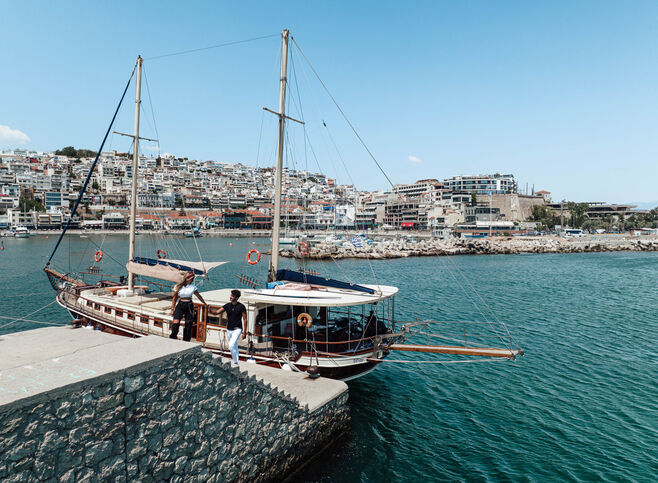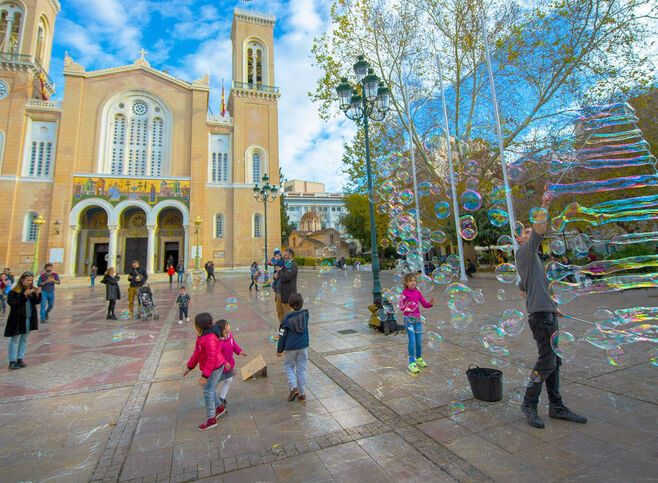- Places to go
- Things to do
- Book your trip
- Get Inspired
- More
- BACK
-
-
Piraeus is not just a bustling port but an intriguing destination in its own right, inviting visitors to explore its markets, bars, squares, yacht marinas and gourmet restaurants, as well as the local hangouts where impromptu bouzouki evenings bring back the spirit of the fifties and sixties.
The largest of three natural bays, Athens’ port houses a cruise liner terminal as well as docks for ferries carrying passengers to all sorts of Greek islands. And just around the coast, the atmosphere changes in the charming seaside neighbourhoods of Microlimano and Pasalimani, with pockets of neoclassical buildings, bars and excellent seafood tavernas
Beyond its modern-day face, Piraeus encapsulates the history of Greece, symbolised by the ruins of the Long Walls, which once reached Athens and tell tales of centuries of decline and rebirth many times over.
Whether you’re about to set off island hopping in the Aegean or maybe embark on a daytrip to the islands close to Athens, it’s worth making time to explore Piraeus. You can follow the route along the seafront from Piraiki to Freatida, with benches beckoning to stop and enjoy the view. Another invitation comes from colourful Pasalimani, a bay with lively bars and cafes that can easily make you lose track of time.
Wooden decks over the water and the rocking yacht masts set the scene for an unforgettable meal at one of Mikrolimano’s restaurants, just around the bay from Piraeus port. The waiters crack jokes and wear smiles as they carry trays heaped with seafood: grilled octopus, shellfish and snapper, fried crayfish tails and other delicacies. Wine glistens in bottles and ouzo turns cloudy as ice cubes melt. Late at night, as the bar scene gets going at the edge of the picturesque harbour, it’s easy to believe that you’re on an island.
At Kastela, you’ll discover a new perspective, looking down on the coast from this elevated and elegant cluster of buildings on the hill. This is your opportunity to view Piraeus through the windows of 19th-century neoclassical mansions, restored and transformed into bistros, bars, cafes and restaurants. Walk through the alleyways and up the steps of the city’s most high-class neighbourhood. At the top, you’ll find the chapel of the Prophet Elijah, an incredible vantage point from which to survey the goings-on in the port.
Piraeus’ architectural appeal centres on its 19th-century buildings: the Municipal Theatre, built in 1884, a symbol of Piraeus and one of the most important theatrical buildings in Greece; the Naval Academy, designed by the famous architect Ernst Ziller; the Hatzikyriakeio, built in 1897; and Piraeus Metro Station with its huge arched roof. This is where the train from Athens terminates, on a line inaugurated in 1930 by one of Greece’s most important historical figures, Eleftherios Venizelos.
Piraeus is famous for its markets. Visit the main shopping mall in the triangle formed by Gounari, Ethikis Antistaseos and Akti Poseidonos streets, or go to Pasalimani where you’ll find even larger malls. As evening falls, the area is overtaken by Piraeus’s nightlife.
At the corner of Syntagmatos St and Pylis St, you’ll come across the remains of the once imposing entrance to Piraeus from Athens. The carriageway along the ancient Long Walls of Piraeus terminated right here.
Piraeus’ flea market is full of vinyl records, old coins, books – and much more besides – on sale at the Sunday bazaar at the trolley terminus. This nostalgic environment is just the thing for people who collect objects and experiences in equal measure.
You can explore eight millennia of history in Piraeus’ museums, with the Maritime Museum and Municipal Gallery housing fine exhibits in very attractive buildings. And a surprise awaits you at the Archaeological Museum, with a Hellenistic-period theatre (reminiscent of the earlier Theatre of Dionysos at the foot of the Acropolis) built right on the grounds.
Invincible in its day, this flagship of the Greek Navy in the early 20th century has great sentimental value for Greeks. Docked at the Trokadero Marina, a little further up the coast from Piraeus towards Paleo Faliro, it is now a fascinating floating museum. Immobile since 1952, it still feels as if it’s ready to sail.




















